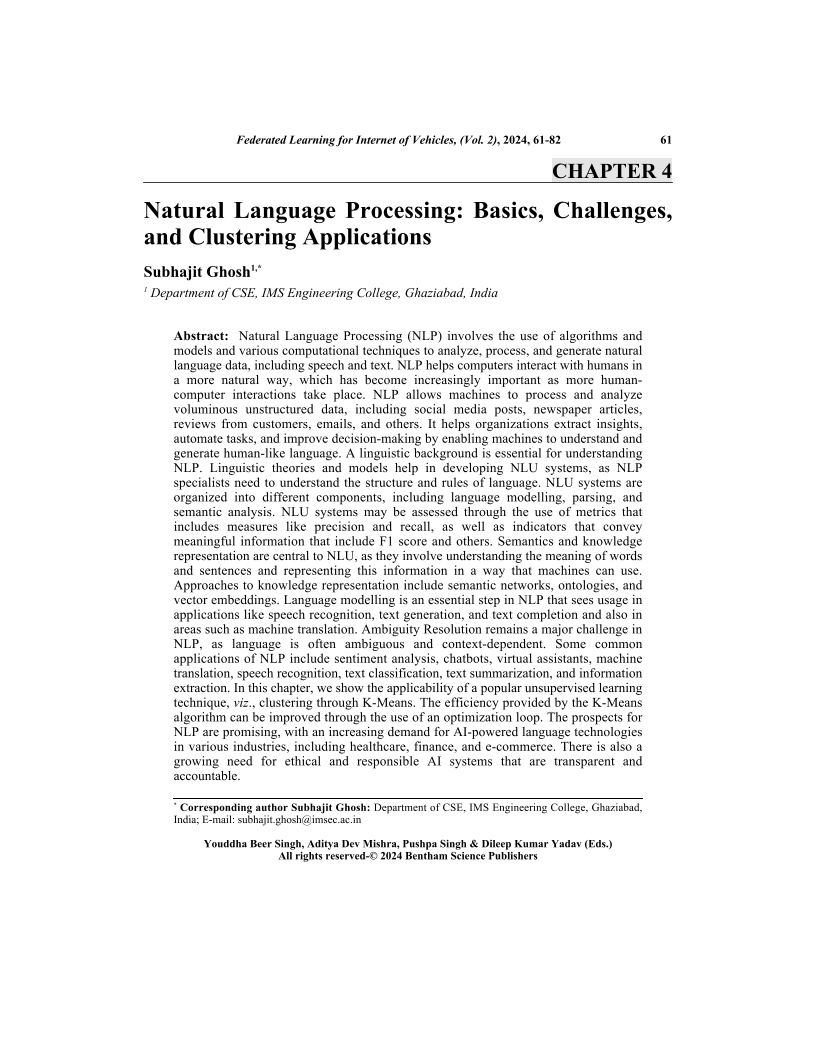- Home
- Books
- A Handbook of Computational Linguistics: Artificial Intelligence in Natural Language Processing
- Chapter
Natural Language Processing: Basics, Challenges, and Clustering Applications

- By Subhajit Ghosh1
-
View Affiliations Hide AffiliationsAffiliations: 1 Department of CSE, IMS Engineering College, Ghaziabad, India
- Source: A Handbook of Computational Linguistics: Artificial Intelligence in Natural Language Processing , pp 61-82
- Publication Date: August 2024
- Language: English
Natural Language Processing: Basics, Challenges, and Clustering Applications, Page 1 of 1
< Previous page | Next page > /docserver/preview/fulltext/9789815238488/chapter-4-1.gif
Natural Language Processing (NLP) involves the use of algorithms and models and various computational techniques to analyze, process, and generate natural language data, including speech and text. NLP helps computers interact with humans in a more natural way, which has become increasingly important as more humancomputer interactions take place. NLP allows machines to process and analyze voluminous unstructured data, including social media posts, newspaper articles, reviews from customers, emails, and others. It helps organizations extract insights, automate tasks, and improve decision-making by enabling machines to understand and generate human-like language. A linguistic background is essential for understanding NLP. Linguistic theories and models help in developing NLU systems, as NLP specialists need to understand the structure and rules of language. NLU systems are organized into different components, including language modelling, parsing, and semantic analysis. NLU systems may be assessed through the use of metrics that includes measures like precision and recall, as well as indicators that convey meaningful information that include F1 score and others. Semantics and knowledge representation are central to NLU, as they involve understanding the meaning of words and sentences and representing this information in a way that machines can use. Approaches to knowledge representation include semantic networks, ontologies, and vector embeddings. Language modelling is an essential step in NLP that sees usage in applications like speech recognition, text generation, and text completion and also in areas such as machine translation. Ambiguity Resolution remains a major challenge in NLP, as language is often ambiguous and context-dependent. Some common applications of NLP include sentiment analysis, chatbots, virtual assistants, machine translation, speech recognition, text classification, text summarization, and information extraction. In this chapter, we show the applicability of a popular unsupervised learning technique, viz., clustering through K-Means. The efficiency provided by the K-Means algorithm can be improved through the use of an optimization loop. The prospects for NLP are promising, with an increasing demand for AI-powered language technologies in various industries, including healthcare, finance, and e-commerce. There is also a growing need for ethical and responsible AI systems that are transparent and accountable.
-
From This Site
/content/books/9789815238488.chapter-4dcterms_subject,pub_keyword-contentType:Journal105

